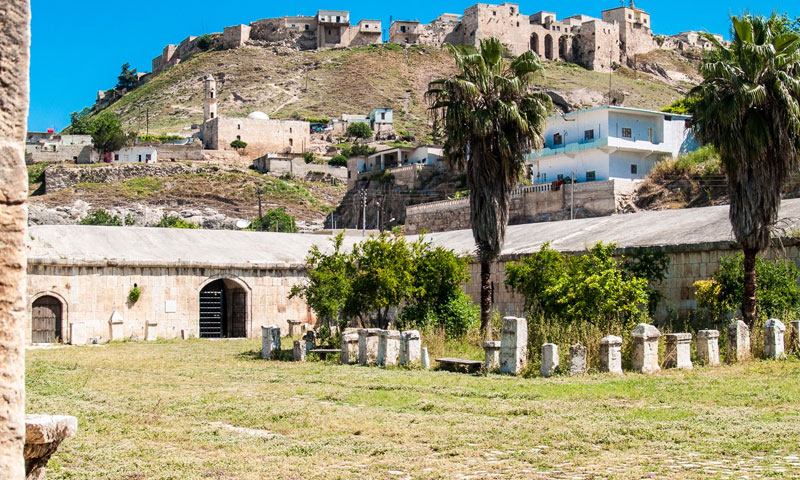



Hama Countryside – Due to its proximity to the ancient city of Apamea, as well as other tourist attractions such as the fortress and the mosaics museum, the ancient town of Qalaat al-Madiq is known for its symbolic historical significance, which the opposition, who controlled the area for years, worked to preserve.
With the Syrian regime taking control of the town last May, official and pro-regime media cameras tried to give the impression of “a great deal of vandalism” perpetrated by Syrian opposition factions.
On 21 May, the official news agency SANA showed pictures of antiquities in the Apamea Mosaic Museum, which it said was intended for smuggling.
The Russian website RT published a report on 13 May, in which it purported that the opposition factions looted and destroyed the contents of the Museum of Qalaat al-Madiq, and repurposed the historic sites as headquarters.
The site also published a report on June 4, in which the director of the archeology in Hama, Abdelkader Farzat, was quoted as saying that the museum, which contains a large number of mosaics, “was vandalized and display halls were broken, while attempts were made to destroy the exhibitions in the courtyard, including crowns and columns, especially the column used to measure distances between the cities of Apamea and Raphanea.” adding that ”there are definitely items missing from the museum, but they have yet to be counted and delineated.”
Enab Baladi contacted the Local Council of Qalaat al-Madiq whose members left the town after the regime took control of the area. Local Council members denied that archaeological sites had been looted or vandalized.
The head of the Local Council of Qalaat al-Madiq, Nasser al-Saeed, stressed that the residents of the town have preserved the historical areas and archaeological sites in the area over the years.
“In the past few years, we have repaired the damage to the museum thanks to the help of supporting organizations by providing mosaics with a layer of sand and cement to keep them from being destroyed and forgotten,” he said.
Jamal Hamid, the former head of the Local Council, corroborated al-Saeed’s narrative.”We renovated the museum in cooperation with the Arab Center for the Protection of Heritage in the city of Maarat al-Numan, and we have cleaned the museum of weeds, dust and damages that resulted from some of the shells that hit the roof.”
Some pro-Syrian regime pages published pictures of sand-covered mosaics, which they claimed was evidence of vandalism or preparation for smuggling.
“We collaborated with the Arab Center for the Protection of Heritage to clean the paintings and put protective pieces of cloth on them with sandbags to protect them from damage, breakage or theft,” he told Enab Baladi, adding that the photographs published confirmed that the paintings were protected.
In the years during which Qalaat al-Madiq was under the control of opposition factions, the town saw repeated bombardment that resulted in the killing of dozens of its residents and several waves of displacement. It also caused damage to the infrastructure, as the ravages of destruction reached archeological sites.
The Museum of the Mosaic, which is located in Qalaat al-Madiq, holds great cultural significance, as it is the only mosaic museum in Syria which preserves and documents the civilizations that have come and gone in the country’s history.
The museum contains a collection of important paintings, according to a report published in the newspaper Asharq al-Awsat in 2005 from the museum, it contains the “Socrates Mosaic” depicting Socrates and six wisemen, which dates back to 362-363 A.D.
In addition to the painting “Mermaids” found in the historic city of Apamea which dates back to 362-363 A.D.
According to the official site of the Directorate of Museums and Antiquities of the Syrian regime government, the museum was an inn that hosted pilgrimage convoys on their way, built during the reign of Ottoman Sultan Sulayman Pasha al-Azm.
The Directorate notes that the building was neglected and saw changes in its features until restoration work began in 1978 and ended in 1982. The museum was reopened as the Apamea Museum in the same year.
if you think the article contain wrong information or you have additional details Send Correction